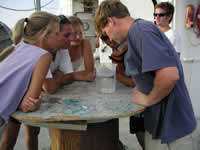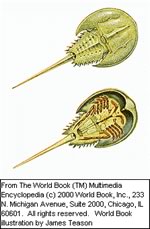


|
The Project Part 1: Part 2: Part 3:
|
08 August, 2005
|
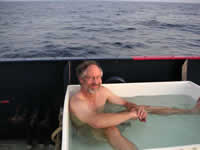 Fred Prahl, Chief Scientist, enjoying an evening soak 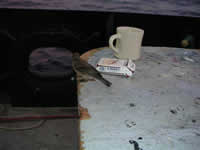 A bird hitches a ride, dropping in for a smoke and a cuppa joe  Eduardo and Luis debark for Guaymas 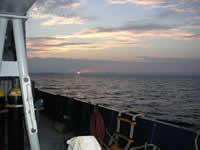 Dawn near Guaymas, August 8, 2005 |
This morning we witnessed another beautiful dawn near Guaymas. Dolphins swam right next to the ship as we entered the harbor to drop off Eduardo and Luis. The pilot boat brought us more fresh fruit and vegetables and sped our Mexican friends back to shore. We thought we had no more opportunity to take more water samples, but the Mexican government granted us permission to do some more sampling today. So at 4 pm, the CTD will go back into the sea to gather water from the Carmen Basin, one of the deepest places in the Gulf of California.
What is the “biological pump?”
Simply put, CO2 (carbon dioxide) in the atmosphere is taken up by plants in the surface waters of the world’s oceans. This CO2 is then transported to the deep ocean by various processes (sinking, plants are consumed by animals and their fecal pellets sink to the deep ocean, mixing, etc.). It’s called the biological pump, because biological organisms are “pumping” atmospheric CO2 to the bottom of the ocean.
Since the beginning of the Industrial Revolution (early to mid-nineteenth century), the amount of carbon dioxide in the atmosphere has increased by about 25 percent and the methane concentration has risen by about 150 percent. Human activity is responsible for most of this increase, primarily from burning fossil fuels (oil, natural gas, and coal).
The growth of urban areas and the clearing of land to build farms have also reduced the amount of oxygen produced by land plants. Fossil fuels contain carbon, and burning them creates carbon dioxide. Trees and other plants absorb the gas through the process of photosynthesis. As land is cleared and forests are cut down, carbon dioxide levels rise, because there are fewer plants to take up CO2 and turn it in to oxygen.
So why does this matter? As we are emitting more CO2 into our atmosphere, we need to understand where it goes. If it builds up in the atmosphere, the earth will potentially get hotter and hotter as CO2 is a greenhouse gas (we’ll get to that in a minute). We know, however, that some fraction of our CO2 emissions is being “pumped” down to the deep ocean by the biological pump. We want to understand the specifics of this pump, so we study the biology (life forms) of the ocean.
What is the “greenhouse effect?”
The greenhouse effect is a warming of the lower atmosphere and surface of the Earth by a complex process involving sunlight, gases, and particles in the atmosphere. The greenhouse effect is so named because the atmosphere acts much like the glass roof and walls of a greenhouse, trapping heat from the sun. This phenomenon is contributing to global warming.
So how is the work of the scientists aboard the R/V New Horizon related to the biological pump and the greenhouse effect? Tune in tomorrow for an answer.
Math Problem:
The little dingy that took Eduardo and Luis back to Guaymas creeps along at 2 miles per hour. It took them 45 minutes to get to Guaymas. How far did they travel?
Horseshoe crabs aren’t really crabs. Their closest living relatives are scorpions and spiders.
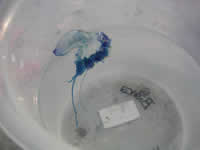
A Portuguese man-of-war,
Phylum: Cnidaria
![]()

